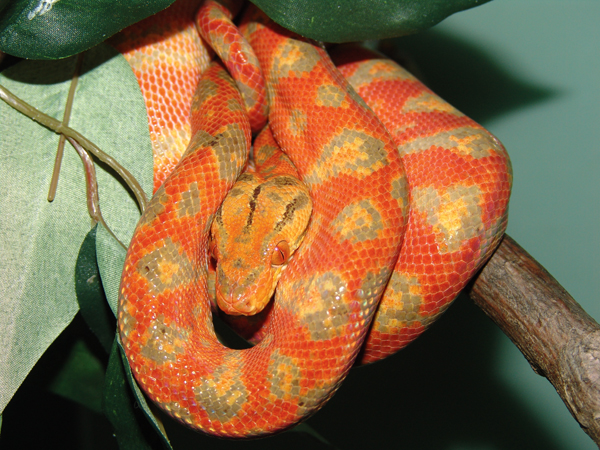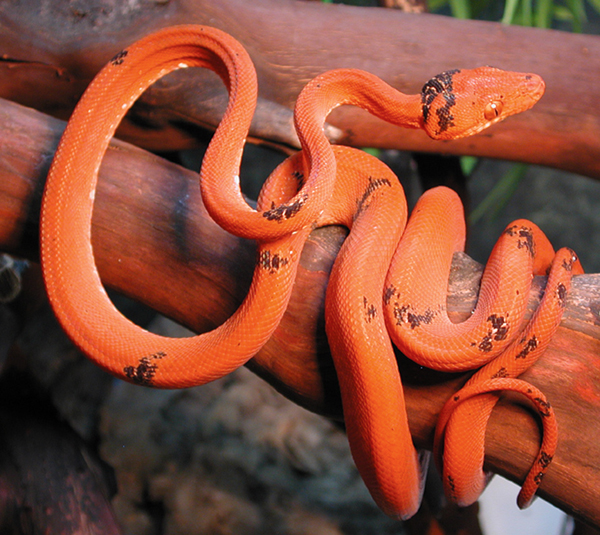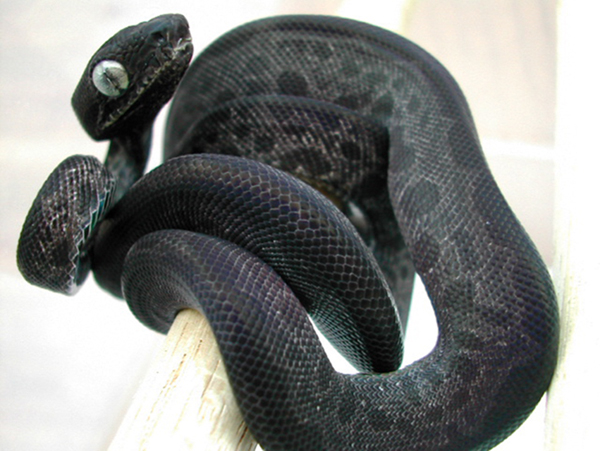Amazon tree boas have been a staple in the pet trade for many decades, but they are, understandably, not everyone’s cup of tea, especially when
Amazon tree boas have been a staple in the pet trade for many decades, but they are, understandably, not everyone’s cup of tea, especially when calm handle-able species like ball pythons dominate the industry. But for those who like to have a bit of an “edge” to their pets, the Amazon tree boa is a contender for an interesting and rewarding pet. As far as visually appealing display species go, you will find that few species can give you the diversity in color. These snakes easily rank in as some of the world’s most beautiful snake species. They come in various shades of reds, oranges and yellows, and there are infinitely varying combinations of colors and patterns…and that’s just the naturally occurring variety!
Tree-Top Royalty
The Amazon tree boa (Corallus hortulanus) is a denizen of the neotropics of South America. Its known geographic range to date is from southern Colombia, east of the Andes Mountains, into southern Venezuela, Suriname (where most of our captive animals originate), French Guiana, Brazil, Ecuador, Peru and Bolivia. Amazon tree boas inhabit various habitats but remain arboreal in nature. They are often found in low-lying vegetation, bushes and, of course, trees at varying heights. Unlike many other reptile species, Amazons seem to adapt well to disturbed areas in the wild and are often found on plantations and in sugar cane fields, where they hunt rodents and bats throughout the evening hours.

Danny Mendez
Tiger Amazon tree boa.
Care for Amazon tree boas is straightforward. The trickiest part about keeping them, from a behavioral standpoint, is learning to calmly manipulate an animal that will likely act defensively. Over time—a lot of time,—they do calm down and become much less defensive. I can service most of my animals using only a roll of paper towels, which acts as a physical and thermal barrier that is not as likely to stimulate them or allow for any injuries. Over time of routine care and interaction, my animals understand that a tap with a paper towel roll means “move along” and not “I want to eat you.” As a result, they usually choose to move away and climb into the cage’s perch network instead of holding their ground (or branch) and start defensive striking.
A warm hand will usually illicit a strike that can be either defensive or food-motivated. Amazon tree boas are slaves to stimuli; if it moves and is warm, it must mean food or foe. But like most well-cared-for pets, they get used to you and the routine, and they eventually calm down. Some individuals can remain nervous. A couple of my oldest Amazons, which are now 18 and 15 years old, both happen to be extremely tame, but I do not recall our relationship starting out so smoothly when they were tenacious little worms.
Amazon Tree Boa Enclosure Tips
Amazon tree boas prefer relatively cooler temperatures as far as boids go, and they will do best when provided with a proper gradient. During the spring, summer and most of the fall months here in the northeast United States, I keep my tree boas with a gradient created by using a basking spot. The cooler portion of the cage remains between 70 and 75 degrees Fahrenheit. The basking area is around 85 to 89 degrees. During late fall and throughout the winter, I like to provide a lower nighttime temperature, between 65 to 69 degrees, to stimulate breeding behavior.

Danny mendez
Red paradox Amazon tree boa.
Although they will readily utilize belly heat in the form of a heat pad or heat tape, I prefer to provide overhead basking for my subadults and adults for a couple reasons. Being arboreal in nature, tree boas likely thermoregulate by basking, so I prefer to use standard incandescent reptile bulbs or infrared heat panels commonly sold in the reptile trade to provide heat from above. This encourages more naturalistic climbing behavior and also keeps the snakes visible, as Amazon tree boas make wonderful display snakes. Being from the neotropics, even in the wild, they experience very little change in photoperiod, so a standard 12 hours of light can be maintained throughout the year. There’s no need to use ultraviolet light, and in fact, some evidence has indicated that excessive exposure has been shown to cause clouding of the eyes and possibly eyesight damage.
When considering housing, make sure it’s big enough to provide the necessary gradient and allow the climbing behavior these snakes exhibit. I keep neonates in a standard reptile rack setup for the first few months, with natural wood perching, but by the six-month mark, I graduate them to acrylic cages with an arboreal setup. This gives them more room and keeps them visible, as I like to ogle my snakes.
The minimum cage size should allow a snake to stretch out horizontally to at least 80 percent of its total body length, especially when it’s gravid or digesting meals. The cage height should be at least half the snake’s length. The more space you can provide for these arboreal acrobats, the better. They will reward you by utilizing every inch of their cages, so get creative with décor.
I caution against keeping more than one Amazon tree boa per enclosure, outside of breeding attempts, especially when feeding. These snakes can be aggressive toward, or confused by, multiple food items, and the first snake finished with its own meal will attempt to steal a cagemate’s food, even if it’s still in the other snake’s grip. This ultimately leads to lots of body-wrapping, musk and bites.
Equally as important as the actual size of the enclosure is its utilization of space and perch arrangement, and the necessary amounts of cover for security. Amazon tree boas will spend a fair amount of time on the ground, more than other Corallus, but it’s important to provide the proper perching microhabitat, as well. Perches should be about as thick as the thickest part of the snake’s body and should have several intersecting branches, as the snakes like to have several points of contact. I provide natural wood perches in the form of branches selected from an area that I am positive has not been treated with herbicides or insecticides. It’s best if you can provide a branch with many forks in it of varying thickness.
Natural wooden perches are loaded with stimulating scents, too, which your snake will spend time exploring. Such smells serve as a form of enrichment for your snake. I try to change out my natural perching every three to four months to provide my snakes with ever-changing physical and mental stimuli.
Potted plants can be used successfully, but they’ll have to withstand your snake climbing and pulling on them. Do not use chemical fertilizers on live plants. I prefer to use artificial foliage because of its durability and how easily I can replace it, not to mention the relative absence of insecticides and other harmful chemicals. Although not necessary, artificial foliage or suspended cork tube hollows will often be appreciated and utilized for cover, especially after meals and during the opaque stage of shedding. Amazon tree boas will readily use any sort of hide box, and it’s best to provide one on the ground and another up in your artificial canopy, preferably away from the heat source. The hide box should be large enough to accommodate your tree boa but still allow for a snug fit, as it will find comfort in being able to squeeze into a relatively small area.
Amazon Tree Boa Diet
Because Amazon tree boas live an arboreal lifestyle, it would be somewhat counterproductive for them to be shaped like a stuffed sausage. Overfeeding is likely the leading cause of premature deaths of these snakes, as they cannot tolerate being power-fed like a colubrid or python. Amazons should be fed appropriately sized meals every seven to 10 days for babies, and every 10 to 14 days for adults. Meals should leave a visible lump, but not one that impedes climbing or seems a burden to lift up onto the branches.

danny mendez
Amazon tree boa leopard morph.
Captive-born babies will usually readily feed on live fuzzy mice, and although the first meal may require some enticing, they are usually aggressive feeders from birth. Some people will start babies on ectothermic prey such as tree frogs or anole lizards, but I believe there’s a huge risk such prey could be vectors for parasites or possibly disease. Even the most stubborn tree boa babies will respond to the fumbling movements of a live fuzzy mouse, which is why I recommend fuzzies over seemingly more appropriately sized pinky mice. After a few live meals, Amazon tree boas will readily switch over to frozen-thawed mice.
Fresh water should always be provided, as Amazon tree boas will quickly dehydrate, especially if you live in a dry climate where it’s hard to maintain the humidity cycles this species requires. Having a large enough bowl for soaking will usually eliminate any shedding issues, as these snakes readily soak in the water. Also provide at least one daily misting, which will often stimulate drinking. Aside from helping with hydration, misting helps maintain ambient humidity levels, which should never dip below 30 percent. After misting, the humidity level will gradually decrease, allowing for a necessary drying period. If the cage is too wet or too dry after the daily misting, then you’ll need to adjust the ventilation, increasing or decreasing it to maintain the preferred humidity range. Ideally, the humidity should spike when misted, upward of 90 percent, and eventually dry out to about 50- to 40-percent ambient humidity.
Although still a regularly imported snake, several generations of captive-born Amazon tree boa babies are available every year thanks to the dedicated work of several hobbyists. These experts continue to focus, as well as refine, some very exciting bloodlines, including the Tiger Amazon, which I had the pleasure of establishing back in the 1990s. Even though these snakes have been bred for multiple generations, there are relatively few morphs, but given the polymorphism displayed by this species, that’s easy to overlook, as naturally endless color combinations can keep you intrigued with every litter.
You do not necessarily have to start off with brightly colored parents to get offspring that turn out to be brightly colored. Garden-phased animals can easily produce brightly colored reds or yellows. Although it’s hard to predict what colors will emerge from a pairing, the produced combinations usually remain consistent when breeding certain pairs. I have seen breathtaking red and yellow animals born from relatively dull-colored gray and black parents, and vice versa. There’s simply no way to predict offspring, which is one of the reasons I love the Amazon tree boa so much. They are the proverbial “box of chocolates,” as mentioned by Forrest Gump, when it comes to the reptile world. That said, there are some amazing results from lineage breeding of this species, including some spectacular morphs, that push all boundaries with every unpredictable polymorphic litter.
Tiger Amazon Tree Boas
In the mid 90s, I was helping my friend, Peter Paterno, who owned Reptile Visions, a small importing business in New Jersey, by unpacking a recent shipment from Suriname, when I was immediately drawn to a uniquely striped gray and black Amazon tree boa such as I had never seen before. I recall negotiating for the snake, and after a lot of pleading and possibly some sobbing, I took her home a few days later. My intention at the time was not to search for the newest Amazon tree boa morph, but to just enjoy my unique specimen. Breeding was not a focus, and it was not until a few years later that, to my great surprise, I learned the co-dominant nature of that snake’s genotype. Today, the Tiger Amazon has been bred for multiple generations on a few different continents, producing an infinite combination of stripes and colors, few of which are alike, thanks to the polymorphic nature of these beautiful beasts. Being a co-dominant expression, all it takes is one Tiger parent to produce oodles of striped and colorful nippy noodles.
Leopard Amazon Tree Boas
Also in the mid 1990s, Ben Siegel would occasionally obtain one or two Amazons annually from his supplier in South America. The snakes routinely sported a unique look with silvery or golden metallic eyes and the presence of characteristically oval markings and a pale gray background, which often changed in color intensity between day and night. He dubbed these “Leopard Amazons,” and a few years later they yielded surprising results when bred together by producing some stunning offspring, including a jet-black baby with silver eyes that later went through an ontogenetic color change to assume the more typical appearance of a Leopard Amazon. It’s thought to be a simple recessive trait, but due to inconsistent breeding success, this theory cannot yet be confirmed.
Calico Amazon Tree B
Calico Amazon tree boas, sometimes referred to as Candycanes, are a line that was first developed by a hobbyist named Fernando Torres. He produced a litter of unusually pale neonates that later displayed large amounts of white splotches and speckles, giving them a stone-washed appearance as they underwent the typical ontogenetic color change as they matured. They were refined by another breeder over the years, who believes them to be dominant or possibly a co-dominant. They have proven to be stunning animals when combined with the palette of color possibilities Amazons bring to the table.
Amazon Tree Boa Morphs
In a world where everyone is looking for the newest color morph of the most readily available snakes, one species has been doing it naturally all along. If you want the perfect combination of color and display with a pinch of personality, then the Amazon tree boa could be for you. It’s not often you get a much better example of eye candy. Few snakes allow you to have a collection in which each individual looks drastically different than the next, without paying high-morph prices. With an edgy attitude and the potential to produce endless color and pattern combinations, the Amazon tree boa is sure to keep you in suspense and always on your toes.
Danny Mendez is a professional zoologist and former zookeeper, who currently produces one of the world’s most popular reptile and conservation web radio shows, UrbanJunglesRadio. He has bred and specialized in Amazon tree boas for more than 20 years and was a founding member of the Amazon Alliance. He is the author of various articles on Amazon tree boas and the website UrbanJungles.com, which is dedicated to Corallus information.


